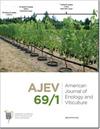High Planting Density Reduces Productivity and Quality of Mechanized Concord Juice Grapes
IF 1.8
3区 农林科学
Q3 BIOTECHNOLOGY & APPLIED MICROBIOLOGY
引用次数: 3
Abstract
The choice of planting density is a key decision for grapegrowers to make before vineyard establishment, with long-term implications. The field trial described here, with drip-irrigated, machine-pruned Concord juice grapes, tested the effects of two between-row distances (2.44 m and 2.74 m) and four within-row distances (0.91, 1.83, 2.74, and 3.66 m), resulting in planting densities ranging from 997 to 4485 vines/ha, on yield formation and fruit composition. Canopy size, yield components, and fruit composition were measured over six years, starting in year 3 after planting. While in the first cropping season the yield with 0.91 m and 1.83 m vine spacing (11.8 t/ha) was twice that with 2.74 m and 3.66 m (5.6 t/ha), on average over the five subsequent years, the yield of 0.91-m vines was 38% lower (18.2 t/ha) than at the other planting distances (29.2 t/ha). During the last four years, the average yield of vines planted with 2.44 m between rows was 2 t/ha greater than that at 2.74 m. The yield potential and fruit quality of closely spaced vines (0.91 m) was compromised by their vigorous growth, high canopy density, and poor microclimate, which resulted in fewer clusters/vine, fewer berries/cluster, lower cluster weights, and more bunch-stem necrosis. Leaf death in the canopy interior was associated with nutrient remobilization and high potassium and pH in the juice from 0.91-m vines. Juice total soluble solids, titratable acidity, and color remained unaffected by planting density. These results show that planting juice grapes at high density in irrigated and highly mechanized vineyards is detrimental to both cropping potential and fruit quality.高种植密度降低机械化协和果汁葡萄的产量和品质
种植密度的选择是葡萄种植者在葡萄园建立之前做出的一个关键决定,具有长期的影响。本文描述的田间试验采用滴灌、机修的康科德果汁葡萄,测试了两种行间距离(2.44米和2.74米)和四种行内距离(0.91米、1.83米、2.74米和3.66米)对产量形成和果实组成的影响,结果种植密度在997至4485株/公顷之间。从种植后第3年开始,连续6年测量冠层大小、产量组成和果实组成。虽然在第一个种植季节,0.91 m和1.83 m的产量(11.8 t/ha)是2.74 m和3.66 m (5.6 t/ha)的两倍,但在随后的5年平均产量中,0.91 m的产量(18.2 t/ha)比其他种植距离(29.2 t/ha)低38%。在过去四年中,行间距为2.44米的葡萄藤平均产量比行间距为2.74米的葡萄藤平均产量高2吨/公顷。密植株系(0.91 m)植株生长旺盛、冠层密度高、小气候条件差,影响了其产量潜力和果实品质,导致串/藤数少、串/果数少、串重低、串茎坏死多。冠层内部叶片死亡与0.91 m葡萄藤汁液中钾和pH值高、养分再动员有关。果汁总可溶性固形物、可滴定酸度和颜色不受种植密度的影响。这些结果表明,在灌溉和高度机械化的葡萄园中,高密度种植果汁葡萄不利于种植潜力和果实品质。
本文章由计算机程序翻译,如有差异,请以英文原文为准。
求助全文
约1分钟内获得全文
求助全文
来源期刊

American Journal of Enology and Viticulture
农林科学-生物工程与应用微生物
CiteScore
3.80
自引率
10.50%
发文量
27
审稿时长
12-24 weeks
期刊介绍:
The American Journal of Enology and Viticulture (AJEV), published quarterly, is an official journal of the American Society for Enology and Viticulture (ASEV) and is the premier journal in the English language dedicated to scientific research on winemaking and grapegrowing. AJEV publishes full-length research papers, literature reviews, research notes, and technical briefs on various aspects of enology and viticulture, including wine chemistry, sensory science, process engineering, wine quality assessments, microbiology, methods development, plant pathogenesis, diseases and pests of grape, rootstock and clonal evaluation, effect of field practices, and grape genetics and breeding. All papers are peer reviewed, and authorship of papers is not limited to members of ASEV. The science editor, along with the viticulture, enology, and associate editors, are drawn from academic and research institutions worldwide and guide the content of the Journal.
 求助内容:
求助内容: 应助结果提醒方式:
应助结果提醒方式:


